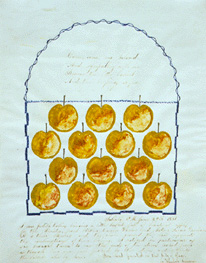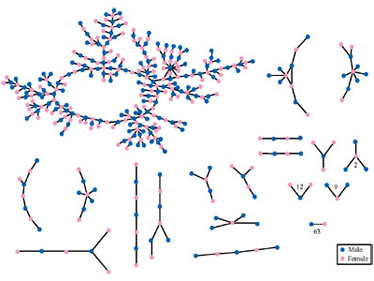Graphic Design & Critical Thinking 2007 (with Luke Bulman)
After I finished the first verison of Graphic Design & Critical Thinking up in December 2006, I remember thinking: “That was so intense, so fun, and I learned so much: but how am I ever going find the energy to do it again?”
Fortunately the answer came by way of my fabulous co-teacher Luke Bulman, principal of Thumb Projects in Brooklyn, NY. Luke took all the great things about the first class and not only kept them but made them better. Rather than sticking to a format where we were leading discussions during every class, Luke suggested that we let students conduct their own discussions in the form of interviews, or Q & As. These interviews would be recorded and form the basis of the journal project, a centerpiece of the class.
What’s so important about the class journal is that in most other forms of graduate education one of the imperatives is to publish, yet very often MFA Graphic Designers, who are perhaps the closest of anyone to the tools of publishing, do not take full advantage of their abilities. At RISD, we’re hoping to build up the tradition of a class journal during the first year, a classwide discussion that forms the basis for students’ thesis work in the second year. Luke’s training as an architect brought essential depth to the students from that area of theory, with which he is much more familiar than myself having trained at Rice as an architect. The result is was a richer journal in every way, and by building the more visual “Projects” into the syllabus as a compliment to the readings, we were able to spend as much of our classtime showing as telling.
Finally, as I was wrapping up the 2006 class and getting feedback from students, I asked them to pardon a particularly inelegant piece of writing because it was simply the best articulation of that idea by a graphic designer. “Why does it have to be by a graphic designer?” one student rightly asked. “This class should be about reading the most useful ideas by the best writers, whoever they are.” I couldn’t have agreed more. In the second time around, with Luke’s invaluable help, I think we finally got it right.
HOW IT WORKS
This seminar is a platform for thinking about design as an engaged cultural practice. There are four seminar formats:
-
Q & A: There will be three to four readings for each thread, and all readings will be presented during 45 minutes of class time. Two people will prepare each reading: an interviewer and a respondent. The interviewer will generate 35 questions on the readings’ intent and implications. The interviewer will then ask a selection of those questions of the respondent and, later, the seminar at large. A list of the interviewer’s questions should be turned in following the class. Collaboration between interviewer and respondent is recommended in organizing the presentation. sessions will be recorded by their presenters. Transcripts of these sessions will be edited to a maximum of 2500 words and submitted along with accompanying images to the publisher using the publisher’s provided template.
-
Projects: There will be several projects presented during each thread. Each project presenter will have 25 minutes to focus on a particular work (book, artwork, exhibition) from the list below. Presentations should thoughtfully answer four fundamental questions: What is it? What does it do? Why (INSERT PROJECT OR AUTHOR NAME HERE)? Why now? These presentations will be primarily visual in nature, however they will need to be thoroughly annotated in order to be effective as explanatory and analytical tools. For the journal, the project will presented in dossier format. The dossier is an organized collection of documents‚ photographs, drawings, quotations, definitions, diagrams, (DON’T STOP HERE)‚ that presents an annotated outline of its subject’s operational and formal aspects. it should be “partially digested.” Wild, exaggerated, or polemic claims for the work are encouraged. Individuals will edit their dossiers and submit them to the publisher for review.
-
Tasks: A task will be given, and three individuals will be asked to share their responses with the class in presentations of 25 minutes each. Tasks may be executed by others on their own initiative. Tasks will be explorative in nature and emphatically open-ended in presentation. For the journal, individuals will formalize their responses and submit them to the publisher for review.
-
Tutorial: Individual sessions with RG and LB for feedback, etc.
JOURNAL
The seminar’s output will be captured in a journal, to be published at the end of the semester. The content of the journal is made up of material from the Q&As, projects, and tasks.
At least 17 copies of this printed journal will be produced; each of you will get one copy, one copy will be sent to us at the addresses below by the due date, and the remaining copy will be filed with the office.
The journal’s pages will be in 6 by 9 inch format (see lulu.com for specifics). Each individual will be responsible for three submissions (one Q&A, one project, and one task), plus a short contributor bio with email and contact information.
One person will be selected as the publisher. The publisher’s primary responsibility will be to publish and distribute the journal accurately and on time. The only way final assignments will be accepted for grading is in a bound journal submitted by the publisher on or before the due date. The publisher will publish pages in the journal in the order they see fit. in all matters, the publisher’s decisions are final.
The publisher will also do the following:
- Paginate the journal’s content
- Create or assign someone to create at Table of Contents
- Create or assign someone to create a Contributors’ page and Colophon
- Name or assign someone to name the journal
- Design or assign someone to design the cover of the journal
- Write or assign someone to write a short introduction to the journal
- Assign a treasurer to handle funds for the journal’s binding
- Assign a production team to oversee accurate delivery of digital files
The publisher will also write a cover letter advising us of problems with the journal, including missing/rejected pages, incomplete contributions, etc. That letter and 1 copy of the journal should be sent to us at our addresses for consideration of a final grade.
INTRODUCTION

Above: A Little Basket Full of Beautiful Apples, 1856, Hannah Cohoon (1781–1864). “Visions and ghosts came down, and the Shakers, chiefly women and young girls, made ‘gift drawings:’ the drawings were gifts from above, not gifts to another. … One of them, ‘A Little Basket Full of Apples’ (1856), is among the key drawings in American art, with a tonic sense of abundance – all the apples just alike, each with its rub-on of rouge, like blush applied by an adolescent girl – allied to obsessive order. From an article in the the New Yorker by Adam Gopnik.
Readings
-
Lorraine Wild: “That was then and this is now: but what is next?” from Emigre 39
-
Stan Allen: “Practice Versus Project” from Practice: Architecture, Technique and Representation
-
Norman Potter: “What is Good Design” from What Is a Designer
Task
Give a gift that will evoke an emotional response when given.
ARCHIVES

Above: A portion of a card catalog of the Bettmann Archive. Purchased by Microsoft/Corbis in 1995, the Bettmann Archive is one of the largest collections of illustration and photography, with over 11 million images. The collection was moved from Manhattan to a former limestone mine in Pennsylvania in 2001. The collection is kept at sub-zero temperatures to ensure its preservation.
Readings
-
Michel Foucault: Preface to The Order of Things
-
Georges Perec: “Think/Classify” from Species of Spaces and Other Pieces
-
Sigmund Freud: “A Note upon a ‘Mystic Writing Pad’” (PDF)
-
Alan Sekula: “Reading an Archive” from Blasted Allegories: An Anthology of Writings by Contemporary Artists
-
Lev Manovitch: “The Database” (PDF)
Projects
-
Gerhard Richter: Atlas
-
Mark Owens: “The Free Library”
-
Clegg and Guttman: “Social Sculpture”
-
Walid Raad: “The Atlas Group Archives”
-
Paul Elliman: “My Typographies”
-
Sol LeWitt: “Autobiography”
Task
Select several unfamiliar books from a library by intuition; relate them.
CITIES

Above: John Edwards Second Life HQ vandalized. Shortly before midnight (CST) on Monday, February 26, a group of republican Second Life users, some sporting “Bush ‘08” tags, vandalized the John Edwards Second Life HQ. They plastered the area with Marxist/Lenninist posters and slogans, a feces spewing obsenity, and a photoshopped picture of John in blackface, all the while harrassing visitors with right-wing nonsense and obsenity-laden abuse of Democrats in general and John Edwards in particular.
Q & A
-
Wim Wenders: “The urban landscape from the point of view of images” from Wim Wenders: On Film
-
Robert Smithson: “Monuments of Passaic” from Collected Writings
-
Rem Koolhaas: “Junkspace” (link)
-
Lars Lerup: “Stim and Dross” from After the City
Projects
-
Sophie Calle: “M’as-tu-vu?” from Did You See Me?
-
Robert Venturi, Denise Scott-Brown, and Steven Izenour: Selections from Learning From Las Vegas
-
Ed Ruscha: “Every Building on the Sunset Strip,” “34 Parking Lots in Los Angeles,” “26 Gasoline Stations” from Editions 1962-1999
-
Atelier Bow-Wow: “Made in Tokyo” (link)
Task
Record the city for one week; present your findings.
CIRCULATIONS

Above: The Structure of Romantic and Sexual Relations at Jefferson High School. Each circle represents a student and lines connecting students represent romatic relations within 6 months preceding the interview. Numbers under the figure count the number of times that pattern was observed.
Q & A
-
Lewis Hyde: Selections from The Gift
-
Georges Bataille: Selections from The Accursed Share
-
Susan Sontag: “Posters: Advertisement, Art, Political Artifact, Commodity” from Looking Closer 3
-
George Kubler: “The Propagation of Things” from The Shape of Time
-
Jonathan Lethem: “The Ecstasy of Influence” from Harpers
Projects
-
Mark Perry: Sniffin’ Glue
-
Joshua Schachter: Delicious bookmarking service
-
Marcel Duchamp: “Box in a Valise” from MoMA
-
Stewart Brand: The Whole Earth Catalog
-
Michael Rock and Susan Sellers: “The Museum of the Ordinary” from Design Beyond Design
Task
Distribute a physical object to at least 10 people, all of whom you do not know; track your inventory.
MANIFESTOS

Above: Man bitten by lion. A man was attacked and injured after jumping into a lion’s den at the Taipei Zoo and trying to convert the lions to Christianity. The 46-year-old man leaped into the den of African lions and shouted “Jesus will save you,” according to the report. He also said, “Come bite me” before one of the male lions attacked and bit the man.
Q & A
-
Ulrich Conrads: Selections from Programs and Manifestos on 20th-Century Architecture
-
Mary Ann Caws, ed.: “The Poetics of the Manifesto: Nowness and Newness” from Manifesto: a century of -isms
-
J.G. Ballard: “Project for a Glossary of the 20th Century” from Incorporations and “What I Believe” from Re-Search 8/9
-
Icon Magazine: “Manifesto”
Projects
-
Sam Anderson: “The Splasher” from New York Magazine
-
Roger Whitehouse: “The AIGA Standard Form of Agreement”
-
Tibor Kalman: “We’re Here to Be Bad” from Perverse Optimist
-
Rem Koolhaas: Selections from Delirious New York
Task
Make a public exclamation; record the event.